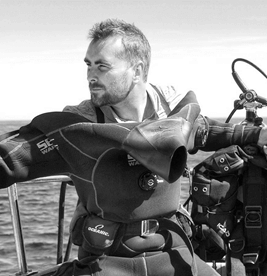
RESEARCH INTERESTS
My research interests are primarily involved in assessing the impacts of natural and anthropogenic stressors on marine organisms and habitats with a particular focus on renewable energy and fisheries. The main themes I am interested in are:
- Quantifying fishing pressures on key model species and understanding behavioural and physiological adaptations developed by commercially important species
- Understanding the impacts of anthropogenic stressors on species and ecosystem levels with an aim to inform policy and industrial practices
- Developing and testing alternative materials derived from the marine environment
- Working to improve the EIA process with regards to offshore renewable energy
CURRENT PROJECTS
- Artificial habitat design and in-depth behavioural analyses of the European lobster, Homarus gammarus
- Impacts of electromagnetic fields from subsea cables on elasmobranchs and marine invertebrates
- Development of marine bioplastics to aid the fishing industry
- Assessing fisheries within a voluntary marine reserve
- Renewable energy multi-stressor assessment on commercially important marine invertebrates
PUBLICATIONS
- Hermans, A., Maris, T., Hubert, J., Rochas, C., Scott, K., Murk, A.J. and Winter, H.V., 2025. From Subsea Power Cable to Small-spotted Catshark Scyliorhinus canicula: behavioural effects of electromagnetic fields in tank experiments. Marine Environmental Research, p.107127.
- Hamilton, F. J. A, Wilkes, J. D., Scott, K. 2024. Ultimate Fighting Crab: Agonistic Behaviour, Dominance, and Recognition in the Edible Crab, Cancer pagurus (L.). Fishes 9(11), 455.
- Easton, Blair Alexander Andrew, Scott, K, Richards, J, Rees, A., 2023. “Catch per Unit Effort of Decapod Species, C. pagurus and H. gammarus, from a Voluntary Marine Reserve” Fishes 8, no. 8: 390.
- Easton, B.A.A., Boon, A., Richards, J. and Scott, K., 2023. Comparing the Size at Onset of Sexual Maturity of Edible Crab (Cancer pagurus, Cancridae) in Berwickshire and Northumberland. Fishes, 8(5), p.260.
- Harsanyi, P., Scott, K., Easton, B.A., de la Cruz Ortiz, G., Chapman, E.C., Piper, A.J., Rochas, C.M. and Lyndon, A.R., 2022. The Effects of Anthropogenic Electromagnetic Fields (EMF) on the Early Development of Two Commercially Important Crustaceans, European Lobster, Homarus gammarus (L.) and Edible Crab, Cancer pagurus (L.). Journal of Marine Science and Engineering, 10(5), p.564.
- Scott, K., Harsanyi, P., Easton, B.A., Piper, A.J., Rochas, C. and Lyndon, A.R., 2021. Exposure to Electromagnetic Fields (EMF) from Submarine Power Cables Can Trigger Strength-Dependent Behavioural and Physiological Responses in Edible Crab, Cancer pagurus (L.). Journal of Marine Science and Engineering, 9(7), p.776.
- Scott, K., Piper, A. J. R., Chapman, E. C. N., and Rochas, C. M. V., 2020. Review of the effects of underwater sound, vibration and electromagnetic fields on crustaceans. Seafish Report.
- Scott, K., Harsanyi, P. and Lyndon, A.R., 2018. Understanding the effects of electromagnetic field emissions from Marine Renewable Energy Devices (MREDs) on the commercially important edible crab, Cancer pagurus (L.). Marine pollution bulletin, 131, pp.580-588.
- Scott, K., Harsanyi, P. and Lyndon, A.R., 2018. Baseline measurements of physiological and behavioural stress markers in the commercially important decapod Cancer pagurus (L.). Journal of Experimental Marine Biology and Ecology, 507, pp.1-7.
EDUCATION
- PhD Understanding the biology of two commercially important crustaceans in relation to fisheries and anthropogenic impacts, Heriot Watt University (2019)
- MRes Marine and Freshwater Ecology and Environmental Management, University of Glasgow, UK (2011)
- BSc (Hons) Applied Marine Biology, Heriot Watt University (2009)
Student Supervision
2021 – 2024 Shravan Ram (PhD): “How do diatoms evolve in a changing ocean habitat”
2021 – 2022 Valentina Ventimiglia (MSc): Investigating the physiological and behavioural changes in the commercially important Velvet Swimming crab, Necora puber (L.), following exposure to Electromagnetic Fields (EMFs)
2021 – 2022 Ziheng Su (MSc): Are crabs in the Berwickshire Marine Reserve protected from microplastic contamination?
2020 – 2021 James Gillespie (MSc): Stuck in the mud? Examining the relationship between offshore wind energy and Nephrops norvegicus fisheries in Scotland.